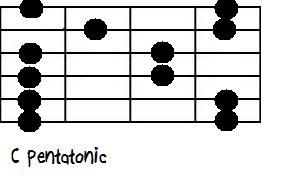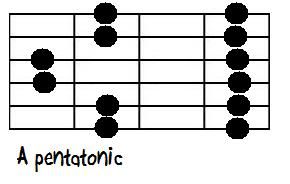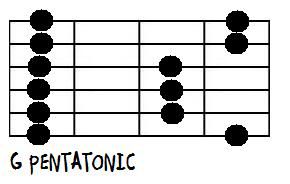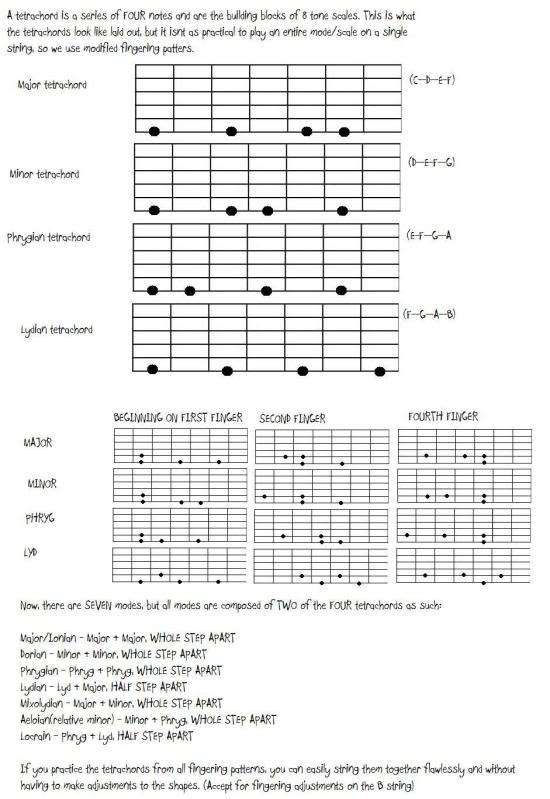Now, lets assume you know something about music, but I'll hopefully fill you in for anything if you need to know it.
Basically there are 5 defined fret shapes/positions to play any chord over the fret board, and these are... wait for it.... C, A, G, E, and D. If you couldnt have guessed that, the rest might be a bit more complicated for you but I'm sure you can grasp it.
Let's also make sure at this point to make a definite distinction between CHORDS and SHAPES. By Shape I mean a regular CHORD played in a postition DIFFERENT than the open position, creating a new CHORD. If you are familiar with using a Capo and transcribing songs to different chords to play on a different fret, then this should be making some sense, but let me further clarify with examples of the most popular SHAPES; E and A
EDIT: some of the damn coding came out weird, but bear with it for a while. the fret numbers below no longer line up with the fret, but if you can count, you can figure it out
EDIT2: and as much as this all looks like english is my second language, I can assure you it is just the hash making me this prone to funny typos
Code: Select all
Alright, 6 strings, 12 frets. Now a G CHORD in the open shape lookss like this(forgive the lack of effort on the detail)
|---|---|-.-|---|---|---|---|---|---|---|---|---|
|---|---|---|---|---|---|---|---|---|---|---|---|
|---|---|---|---|---|---|---|---|---|---|---|---|
|---|---|---|---|---|---|---|---|---|---|---|---|
|---|-.-|---|---|---|---|---|---|---|---|---|---|
|---|---|-.-|---|---|---|---|---|---|---|---|---|
3 5 7 9 12
And the most common Barred form of G CHORD is the E SHAPE, 3RD POSITION like so
|---|---|-.-|---|---|---|---|---|---|---|---|---|
|---|---|-.-|---|---|---|---|---|---|---|---|---|
|---|---|---|-.-|---|---|---|---|---|---|---|---|
|---|---|---|---|-.-|---|---|---|---|---|---|---|
|---|---|---|---|-.-|---|---|---|---|---|---|---|
|---|---|-.-|---|---|---|---|---|---|---|---|---|
3 5 7 9 12
Now lets see that with the C CHORD open(below) and the C CHORD, A SHAPE 3RD POSITION(second diagram)
|---|---|---|---|---|---|---|---|---|---|---|---|
|-.-|---|---|---|---|---|---|---|---|---|---|---|
|---|---|---|---|---|---|---|---|---|---|---|---|
|---|-.-|---|---|---|---|---|---|---|---|---|---|
|---|---|-.-|---|---|---|---|---|---|---|---|---|
|---|---|---|---|---|---|---|---|---|---|---|---|
3 5 7 9 12
|---|---|-.-|---|---|---|---|---|---|---|---|---|
|---|---|---|---|-.-|---|---|---|---|---|---|---|
|---|---|---|---|-.-|---|---|---|---|---|---|---|
|---|---|---|---|-.-|---|---|---|---|---|---|---|
|---|---|-.-|---|---|---|---|---|---|---|---|---|
|---|---|---|---|---|---|---|---|---|---|---|---|
3 5 7 9 12
Like the G CHORD above, both of these fingerings are the C CHORD but played in a different position. Those positions are the most popular as I've said, but not the only ones' if you limit yourself to those two, you great inhibit your ability to play.
Code: Select all
C CHORD
|---|---|---|---|---|---|---|---|---|---|---|---|
|-.-|---|---|---|---|---|---|---|---|---|---|---|
|---|---|---|---|---|---|---|---|---|---|---|---|
|---|-.-|---|---|---|---|---|---|---|---|---|---|
|---|---|-.-|---|---|---|---|---|---|---|---|---|
|---|---|---|---|---|---|---|---|---|---|---|---|
A CHORD
|---|---|---|---|---|---|---|---|---|---|---|---|
|---|-.-|---|---|---|---|---|---|---|---|---|---|
|---|-.-|---|---|---|---|---|---|---|---|---|---|
|---|-.-|---|---|---|---|---|---|---|---|---|---|
|---|---|---|---|---|---|---|---|---|---|---|---|
|---|---|---|---|---|---|---|---|---|---|---|---|
G CHORD
|---|---|-.-|---|---|---|---|---|---|---|---|---|
|---|---|---|---|---|---|---|---|---|---|---|---|
|---|---|---|---|---|---|---|---|---|---|---|---|
|---|---|---|---|---|---|---|---|---|---|---|---|
|---|-.-|---|---|---|---|---|---|---|---|---|---|
|---|---|-.-|---|---|---|---|---|---|---|---|---|
E CHORD
|---|---|---|---|---|---|---|---|---|---|---|---|
|---|---|---|---|---|---|---|---|---|---|---|---|
|-.-|---|---|---|---|---|---|---|---|---|---|---|
|---|-.-|---|---|---|---|---|---|---|---|---|---|
|---|-.-|---|---|---|---|---|---|---|---|---|---|
|---|---|---|---|---|---|---|---|---|---|---|---|
D CHORD
|---|-.-|---|---|---|---|---|---|---|---|---|---|
|---|---|-.-|---|---|---|---|---|---|---|---|---|
|---|-.-|---|---|---|---|---|---|---|---|---|---|
|---|---|---|---|---|---|---|---|---|---|---|---|
|---|---|---|---|---|---|---|---|---|---|---|---|
|---|---|---|---|---|---|---|---|---|---|---|---|
Code: Select all
|C FORM (o) |
_______|A FORM(3) |
____________|G FORM(5) |
______________________|E FORM(8) |
____________________________|D FORM (10) |
|---|---|---|---|---|---|---|-.-|---|---|---|-.-|
|-.-|---|---|---|-.-|---|---|---|---|---|---|---|-.-|
|---|---|---|---|-.-|---|---|---|-.-|---|---|-.-|
|---|-.-|---|---|-.-|---|---|---|---|-.-|---|---|
|---|---|-.-|---|---|---|-.-|---|---|-.-|---|---|
|---|---|---|---|---|---|---|-.-|---|---|---|---|
3 5 7 9 12 13/octave
Now this CAGED patter is transposible all over the fretboard and it runs through. Let me explain with an example, see above the G CHORD, E FORM example. You have the G FORM open position, E FORM 3RD POSITION making a G CHORD, and with the pattern following (G E D C A[CAGED but starting on G and rolling over to the start]) like D FORM 5th POSITION, C FORM 8TH POSITION, A FORM 10TH POSITION, all of these forming the G CHORD.
OK so I'm kinda hungry and need a break. If there is more interest in this, or if I'm feeling bored I'll pick this up and break down how to easily play scales in any chord all over the fretboard. fun stuff.









